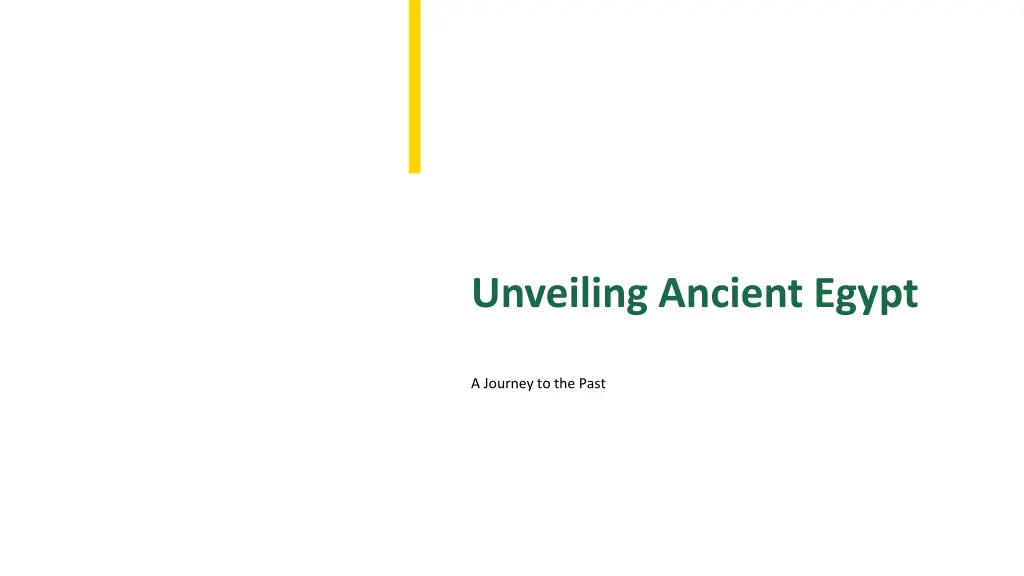
Unveiling Ancient Egypt - A Fascinating Journey to the Past
Explore the birth of civilization in Ancient Egypt around 3150 BC, its reliance on the Nile River, art and architecture, polytheistic religion, divine pharaohs, and the rich cultural heritage that continues to captivate hearts today.
Download Presentation

Please find below an Image/Link to download the presentation.
The content on the website is provided AS IS for your information and personal use only. It may not be sold, licensed, or shared on other websites without obtaining consent from the author. If you encounter any issues during the download, it is possible that the publisher has removed the file from their server.
You are allowed to download the files provided on this website for personal or commercial use, subject to the condition that they are used lawfully. All files are the property of their respective owners.
The content on the website is provided AS IS for your information and personal use only. It may not be sold, licensed, or shared on other websites without obtaining consent from the author.
E N D
Presentation Transcript
Unveiling Ancient Egypt A Journey to the Past Photo by Pexels
01 The Birth of Civilization Table of Contents 02 The Nile River: Lifeblood of Egypt 03 Art and Architecture 04 Religion and Mythology 05 Pharaohs: Rulers and Gods 06 Society and Daily Life 07 Innovation and Science 08 Trade and Economy 09 Decline and Legacy 10 Thank You!
1 The Birth of Civilization 3150 BC Ancient Egypt was founded around 3150 BC, marking a significant point in history where civilization began to flourish. This rich civilization emerged alongside the Nile River, which served as a lifeline for agriculture and trade. Understanding its roots helps us appreciate the advancements that occurred over thousands of years in arts, science, and technology. The timeline of Ancient Egypt continues to inspire curiosity and academic exploration today. Photo by Pexels
2 The Nile River: Lifeblood of Egypt Source of Life The Nile River is the world's longest river, stretching over 6,650 kilometers, essential for agriculture in ancient times. Its annual flooding deposited nutrient-rich silt on the land, allowing crops to flourish and supporting a robust population. Trade routes along the Nile facilitated cultural exchange and economic prosperity, connecting various regions of ancient Egypt. The Nile was not just a river; it was the very heart of Egyptian life and civilization. Photo by Pexels
3 Art and Architecture Timeless Legacy Ancient Egyptians excelled in art and architecture, creating magnificent structures like pyramids and temples that still stand. These symbols of power and spirituality reflect the intricate beliefs and rituals of the society. Hieroglyphics, the ancient writing system, adorned monuments and provided insights into their history and culture. Ancient Egypt's artistic legacy profoundly influences modern art and architecture aroundthe globe. Photo by Pexels
4 Religion and Mythology A Divine Connection Religion in Ancient Egypt was polytheistic, worshipping a multitude of gods and goddesses who governed various aspects of life. Mythology played a central role, shaping cultural practices, rituals, and the understanding of life and death. The belief in an afterlife led to elaborate burial practices, including mummification and the construction of grand tombs. These religious practices reflect the deep spirituality and philosophical inquiries of ancient Egyptians. Photo by Pexels
5 Pharaohs: Rulers and Gods Divine Leadership Pharaohs were considered both political leaders and divine figures, central to the functioning of ancient Egyptian society. Their authority derived from their perceived connection to the gods, emphasizing the intertwining of governance and spirituality. The accomplishments of pharaohs, such as military victories and monumental building projects, showcased their power and influence. The legacy of pharaohs continues to captivate imaginations and inspire scholarly research. Photo by Pexels
6 Society and Daily Life Cultural Fabric Ancient Egyptian society was stratified, with roles ranging from farmers and laborers to nobles and priests. Daily life revolved around agriculture, trade, family, and religious practices, forming a cohesive community structure. Craftsmanship flourished, producing jewelry, pottery, and textiles that reflected both functionality and artistic expression. Social dynamics in ancient Egypt offer valuable insights into the complexities of human interaction and cultural development. Photo by Pexels
7 Innovation and Science Pioneers of Knowledge Ancient Egyptians made significant advances in mathematics, medicine, and astronomy, laying foundations for future disciplines. They developed a 365-day calendar based on lunar and solar cycles, enhancing agricultural planning and governance. Innovations in surgical techniques and medical understanding influenced practices for centuries to come. The scientific legacy of Ancient Egypt showcases the brilliance and inquiryof its people. Photo by Pexels
8 Trade and Economy Economic Powerhouse Ancient Egypt engaged in extensive trade, exchanging goods like grain, papyrus, and gold with neighboringcivilizations. These economic interactions facilitated cultural exchanges and enriched the society's resources and knowledge. The wealth generated from agriculture and trade enabled monumental constructions and supported a thriving civilization. Trade routes connected Egypt to regions as far as the Mediterranean and beyond, showcasing their economic prowess. Photo by Pexels
9 Decline and Legacy A Civilization's End Despite its achievements, Ancient Egypt faced gradual decline due to invasions, internal strife, and resource depletion. The fall of the civilization did not erase its impact; rather, it influenced subsequentcultures and civilizations. Modern understanding of Ancient Egypt is shaped by archaeological discoveries and historical research, preserving its legacy. The fascination with Ancient Egypt continues, inspiring movies, literature,and academic inquiries. Photo by Pexels
10 Thank You! We Appreciate Your Time Thank you for exploring the wonders of Ancient Egypt with us today. We hope this journey through time has inspired a deeper appreciationfor this incredible civilization. Feel free to reach out with any questions or thoughts you may have about this presentation. Let us continue to learn from the past to enrich our future. Photo by Pexels
